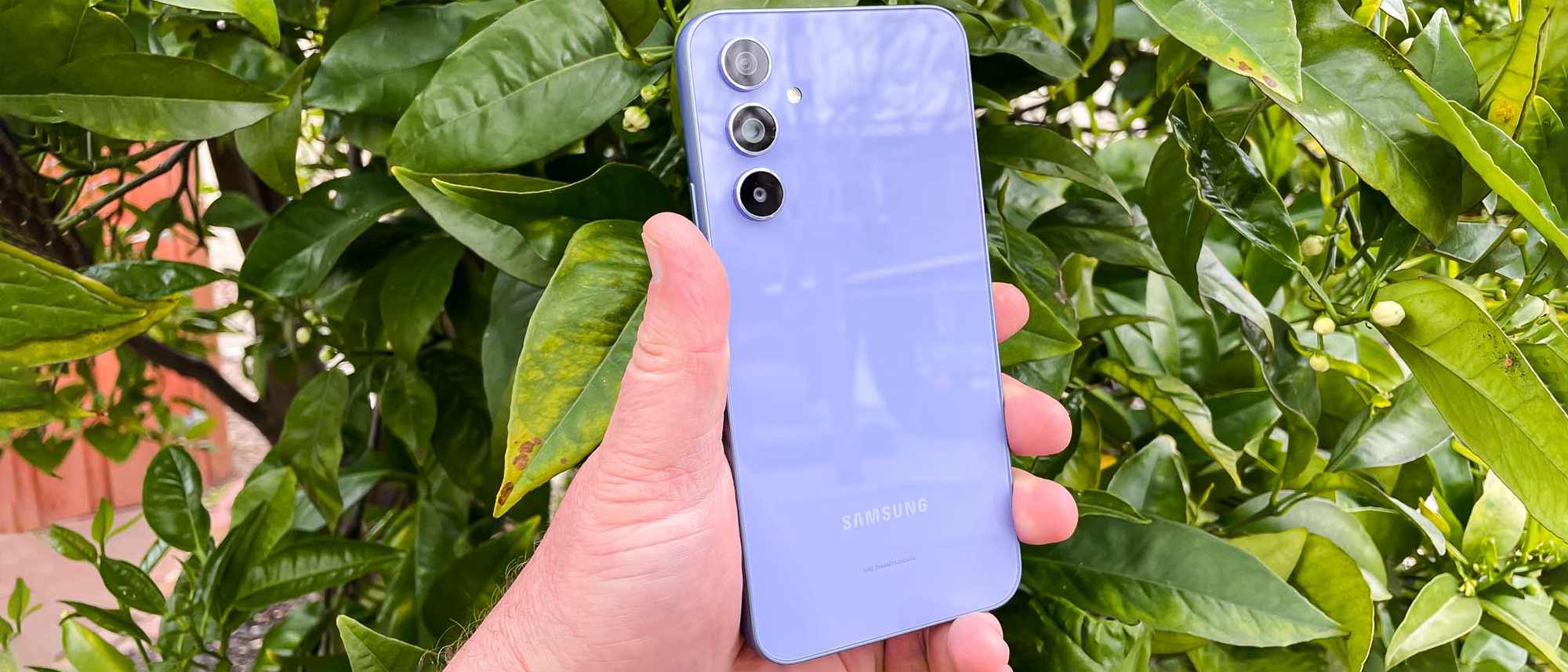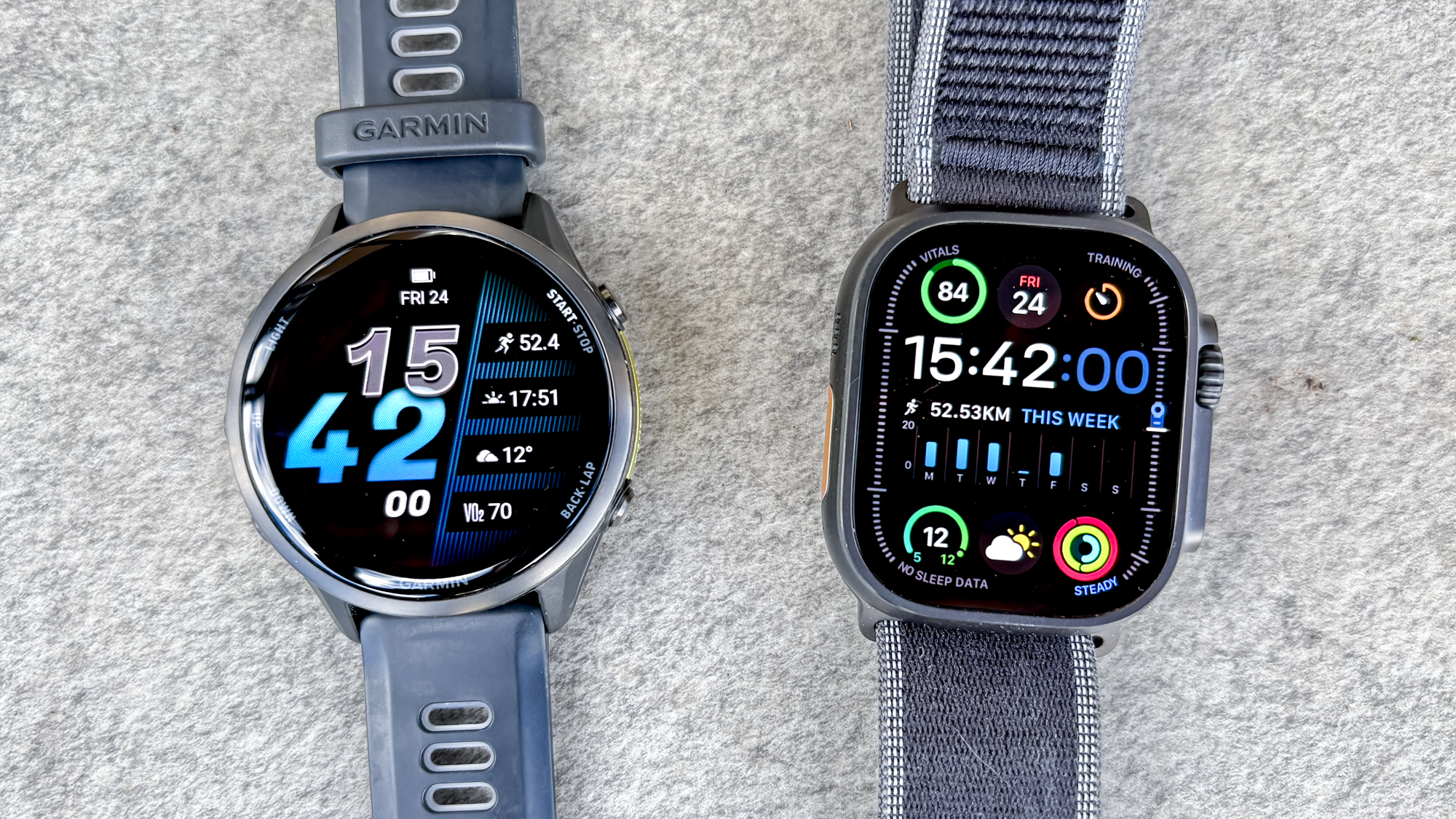Tom's Guide Verdict
The Samsung Galaxy A54 offers solid battery life, a bright and colorful display and an improved main camera that's great when the lights are low. It's the best phone for under $500 — at least until we see what the Google Pixel 7a has to offer.
Pros
- +
Improved 50MP main camera
- +
Excellent shots in low light
- +
Fun colors
- +
Bright, colorful display
- +
Very good battery life
Cons
- -
No wireless charging
- -
Only modest performance gains from predecessor
- -
Noticeable bezel
Why you can trust Tom's Guide
The Samsung Galaxy A54 marks the latest entry in the phone maker's increasingly impressive lineup of midrange phones, and it arrives at an interesting time. For more than a year, Samsung and Google have been trading body blows, as each one tries to one-up the other in the battle to make the best cheap phone you can get for less than $500.
The Galaxy A54 can make a pretty good claim for that title. It takes everything great about last year's Galaxy A53 and improves upon it — the screen is brighter, the battery life longer and the main camera much improved. The Google Pixel 7a is going to have its work cut out for it if its next budget phone is going to surpass the Galaxy A54.
In this Samsung Galaxy A54 review, we'll look at what's new with Samsung's latest midrange phone and why it's the Android phone to get if you don't want to spend more than $500 on your next handset.
Samsung Galaxy A54 specs
| Starting price | $449/£449/AU$699 |
| Screen size | 6.4-inch FHD AMOLED |
| Refresh rate | 120Hz |
| CPU | Exynos 1380 |
| RAM | 6GB, 8GB (U.K-only) |
| Storage | 128GB, 256GB (U.K.-only) |
| Expandable storage? | Yes, up to 1TB |
| Rear cameras | 50MP main (f/1.8), 12MP ultrawide (f/2.2), 5MP macro (f/2.4) |
| Front cameras | 32MP (f/2.2) |
| Battery size | 5,000 mAh |
| Battery life (Hrs:Mins) | 10:20 (adaptive); 11:46 (60Hz) |
| Charging speed | 25W wired, no wireless charging |
| Size | 6.2 x 3.0 x 0.32 inches (158.2 x 76.7 x 8.2mm) |
| Weight | 7.1 ounces (202 grams) |
| Colors | Awesome Graphite, Awesome White, Awesome Lime, Awesome Violet |
Samsung Galaxy A54 review: Price and availability
You can buy the Galaxy A54 right now for $449/£449/AU$699. That gets you a 128GB phone with 6GB of RAM, and you can add to the on-board storage via the phone's microSD slot. The U.K. base model has an extra 2GB of RAM and you can upgrade to 256GB of storage of an extra £50. The best Galaxy A54 deals can help you track down discounts from Samsung, wireless carriers and retailers offering the phone.
The Galaxy A54's price puts it at $350 less than the Galaxy S23, giving you the chance to save big if you don't need the premium features of Samsung's flagship. Among phones in its price range, the Galaxy A54 costs as much as the Google Pixel 6a, with rumors suggesting the upcoming Pixel 7a will cost $50 more. The iPhone SE (2022) undercuts all those devices with a $429 starting price.
Samsung Galaxy A54 review: Design
Samsung is using a similar design language for its midrange phones as it does for its flagships, and that's good news for the Galaxy A54. On the back of the phone instead of a separate camera bump you get three descending lenses on the Galaxy A54, just as you would with any of the recent Galaxy S23 models. The lenses on the Galaxy A54 stick out a little more than the S23's cameras, so Samsung's midrange phone wobbles a bit more when you lay it down with the screen facing up.
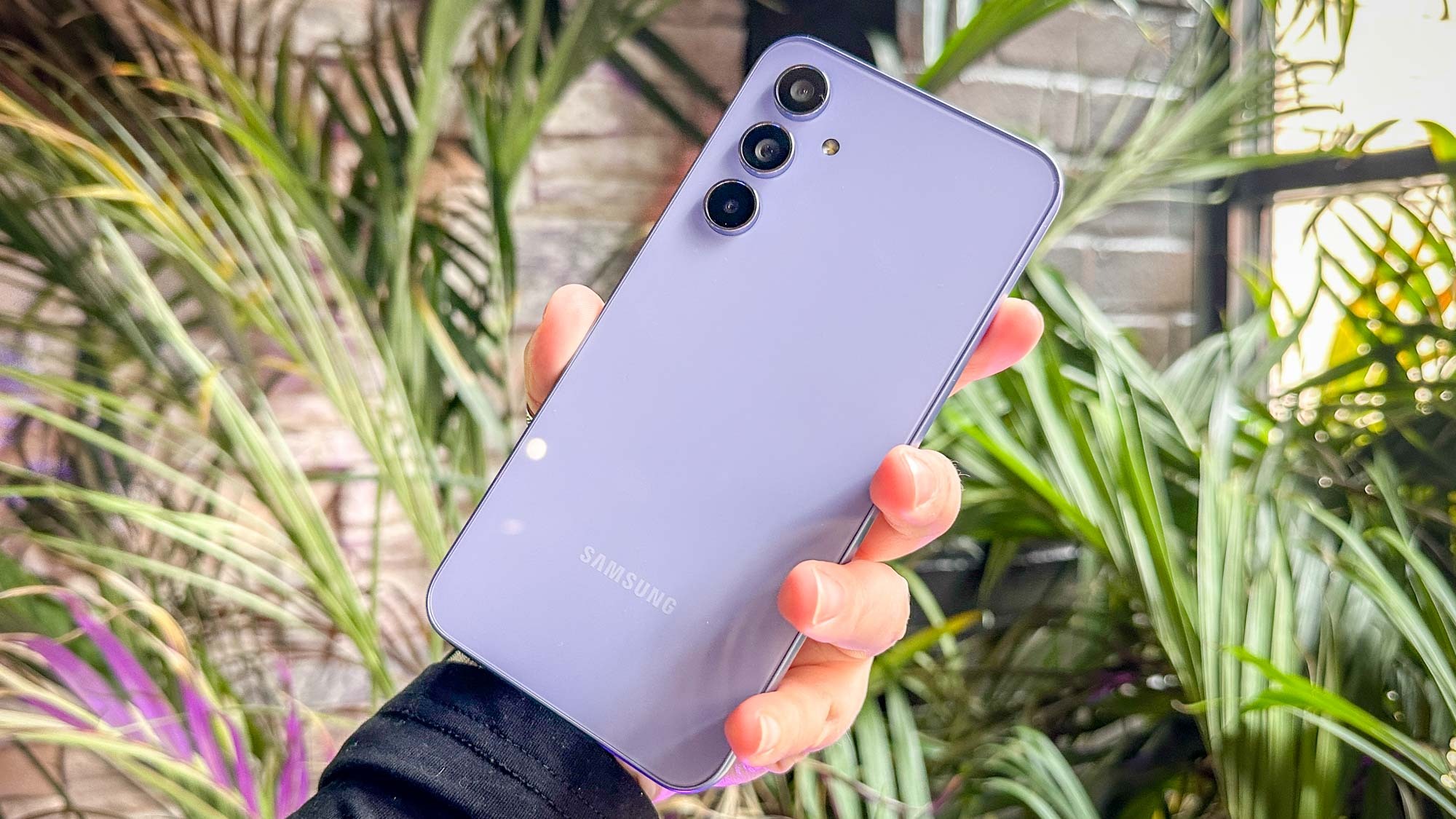
You'll find cheaper materials are used in the Galaxy A54. The back of the phone has a plastic feel, and Samsung is using Gorilla Glass 5 on the A54 instead of the tougher Gorilla Glass Victus 2 featured on the Galaxy S23 models. You get an IP67 water resistance rating with the A54, so it can survive a dunk in 1 meter for up to 30 minutes. That's not as extensive as the Galaxy S23's IP68 rating, but it still suggests a lot of durability for a midrange phone.
Get instant access to breaking news, the hottest reviews, great deals and helpful tips.
One difference between the Galaxy A54 and Galaxy S23 that I really appreciate is Samsung's use of color. On my Awesome Violet review unit, the same purple color that adorned the back panel of the phone could also be seen on its side frame. Other color options include graphite, white and lime.

The Galaxy A54 features a fingerprint reader underneath the front display. I found it to be a little finicky during setup — this is the first time in a decade-and-a-half of phone testing that I've failed to register a fingerprint on first attempt. But eventually the sensor was able to scan my print and I had no subsequent problem unlocking my phone.
Samsung Galaxy A54 review: Display
Samsung has equipped the Galaxy A54 with a 6.4-inch AMOLED screen, so that this midrange phone slots in nicely between the 6.1-inch Galaxy S23 and 6.6-inch Galaxy S23 Plus in terms of screen size. The Galaxy A54 display has something else in common with those flagships — it can scale up its refresh rate to 120Hz when the action on the screen would benefit from smoother scrolling or more immersive graphics.

Last year's Galaxy A53 had a 120Hz refresh rate, but it was fixed so you had to manually toggle between 120Hz and 60Hz, switching to the lower refresh rate when you wanted to save battery. This year, the Galaxy A54's refresh rate is listed as adaptive, so it can scale up to 120Hz on its own. That's a big step forward and furthers the gap between Samsung's phone and devices like the Pixel 6a and iPhone SE, both of which feature static 60Hz screens.
| Samsung Galaxy A54 | Pixel 6a | iPhone SE | |
| Display size | 6.4-inch AMOLED | 6.1-inch OLED | 4.7-inch LCD |
| sRGB (%) | 127.1% (Natural) | 111.1% (Natural) | 114.7% |
| DCI-P3 (%) | 90% (Natural) | 78.7% (Natural) | 87.2% |
| Delta-E | 0.06 | 0.20 | 0.21 |
| Peak brightness | 854 nits | 778 nits | 590 nits |
While we're comparing the displays of those three phones, the Galaxy A54 is the most colorful of the bunch, showcasing 127.1% of the sRGB color spectrum and 90% of the more demanding DCI-P3 color gamut. In its Natural mode, the Pixel 6a — which also uses an OLED panel — showed off 111.1% of the sRGB spectrum and 78.7% of the DCI-P3 color gamut, while the LCD-equipped iPhone SE turned in numbers of 114.7% and 81.2%. The Galaxy A54 proved to have the most accurate colors, too, as its Delta-E rating of 0.06 was the closest to zero, which is the standard for color accuracy.
My video watching certainly bore those numbers out. Streaming the trailer for Blue Beetle on YouTube, Jaime Reyes' neon blue outfit contrasted nicely with the rippling blue waters that he nearly plunged into after his free fall from space. Watching Cocaine Bear on Peacock proved to be suitably bloody on the Galaxy A54's screen.
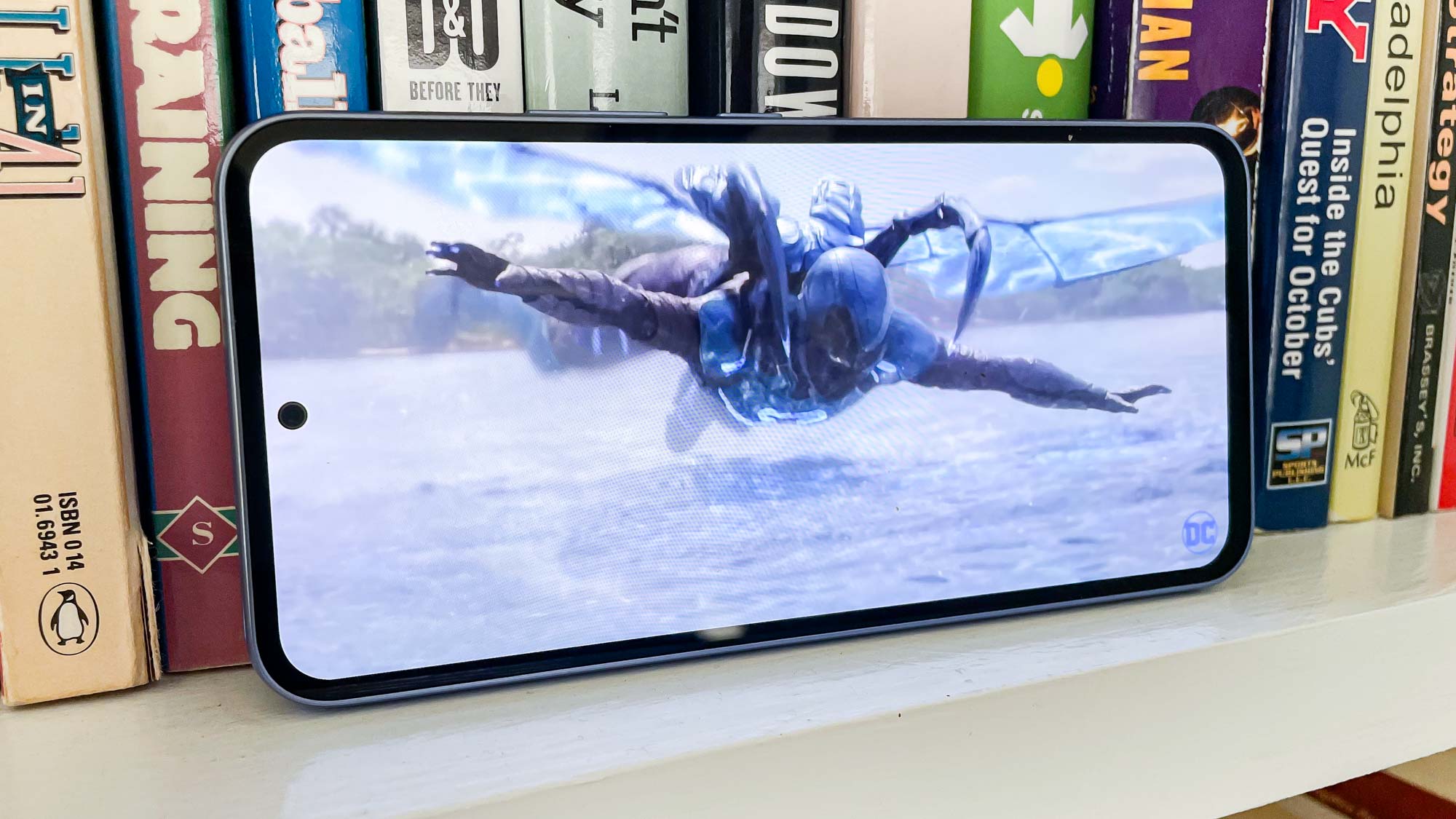
Really, my only complaint with the Galaxy A54 display comes down to the bezels, which are pretty noticeable around the top and bottom of the phone. Maybe it's because I review all sorts of phones with edge-to-edge displays, but any sort of bezel sticks out to me; maybe if you're upgrading from another budget phone, you won't have this issue.
While the Galaxy A54 can match the 120Hz refresh rate of its Galaxy S counterparts, there's one area where it's more limited — screen brightness. While all three Galaxy S23 models boast a maximum brightness of 1,750 nits, the Galaxy A54 caps things at 1,000 nits.
The Galaxy A54 actually gets close to that limit, hitting 854 nits when we used a light meter to measure brightness. That's better than the Pixel 6a's 778-nit reading, and it's certainly bright enough to see the Samsung screen in daylight. (You may want to turn off adaptive brightness, though, to better see the screen.)
Samsung Galaxy A54 review: Cameras
The days of phone makers equipping midrange models with second-rate cameras are over. If you want your handset to be taken seriously as an alternative to flagship phones, you need some quality hardware. And the Galaxy A54 is up to the task, at least in terms of its main camera.

The 50MP lens with an f/1.8 aperture matches the specs on the Galaxy S23 and its main camera. Considering how well that latter device performed in our camera testing — we currently include the Galaxy S23 among the best camera phones we've tested, even if it's not as feature-packed as the Galaxy S23 Ultra — that gives the Galaxy A54 a leg up.
There are two other rear cameras on the Galaxy A54, though the setup is similar to what the Galaxy A52 offered. You get a 12MP ultrawide shooter along with a 5MP macro lens. If someone can explain to me why phone makers keep putting macros lenses on their devices, I would greatly appreciate it.
But let's focus on the cameras you'll actually get some use from, and see how they compare to the Pixel 6a and iPhone SE, which are formidable budget camera phones in their own right.
Some breakfast tacos shot in unflattering light — there's sunlight streaming in from the back of the shot — gives the Galaxy A54 a chance to show off what that larger sensor can do for detail and color. It produces a bright image of the tacos, with different colored vegetables standing out from the yellow scrambled eggs and shards of cheddar cheese. The Pixel 6a's effort is too dark — clearly, it couldn't adjust for the backlighting from the window, and you have to strain to make out the details.
The Galaxy A54 has its own issues with lighting in this picture from a local fruit stand. Because some of the melons and squashes are partially exposed to some bright sunlight, the Galaxy A54 overexposes sections of the photo. The balance is much better in the iPhone SE's shot, particularly on that watermelon in the foreground. It's depicted with a richer green and less glare than you see from the Galaxy A54's photo.
The California lilac bush in my backyard provides another interesting contrast in how the Galaxy A54 and iPhone SE approach color. The Galaxy's shot is the more accurate one, but the colors are fairly muted. The iPhone SE has pumped up the colors to the point where they're almost over-saturated. Still, it's the photo I'd be tempted to share as there's something eye-catching about those purple flowers. I also think the patches of blue sky are more attractive in the iPhone SE's photo.
Moving inside to a display of Star Wars figures at a local toy shop, the Galaxy A54 does a better job handling the challenges of this particular photo — some unforgiving store lighting and a glass case that can potentially distort the view of that army of Star Wars characters. The Pixel 6a's effort is just too dark. You can't make out characters in the back of the display the way you can in the more balanced Galaxy A54 photo. Yes, there's a distracting glare from the glass on the right edge of the A54's shot, but overall, this is a bright, focused photo.
If there's an area where the Galaxy A54 cameras fall flat, it's portrait shots. This particular example shows off the Galaxy A54's effort against the Pixel 6a, but the same held true when I took a portrait photo with the iPhone SE. The Galaxy A54 whitewashes my daughter's face, making her look very pale. The other phone — the Pixel 6a in this instance — offers warmer colors that make for a more appealing photo. I think the Pixel 6a's bokeh effect is more thorough, too.
When we move to the Galaxy A54's ultrawide lens, we get a mixed bag of results. Samsung's phone has sacrificed detail in favor of color — the A54 shot is much brighter and more inviting than what the Pixel 6a mustered. But you can see more detail in the building bricks of the Pixel 6a, even as dark as the cast is on the photo. Both camera phones added a noticeable fisheye effect to their respective shots.
Samsung has put a lot of emphasis on low light photography with recent phone releases, and it's good to see that effort trickle down to midrange models like the Galaxy A54. This mural looks a lot brighter and more colorful in the Galaxy A54's shot, and the cherry blossoms on the right side of the wall stand out more than they do in the Pixel 6a shot, even if the Galaxy A54 photo has more of a pronounced glare from the street lights.
The Pixel 6a has over-compensated for the yellow cast of the street lights, darkening the overall photo, and the result is a more clear photo from the Galaxy A54. I like how Samsung's photo also keeps the house on the left side of the shot in focus, while a little blur has crept into the Pixel 6a's effort.
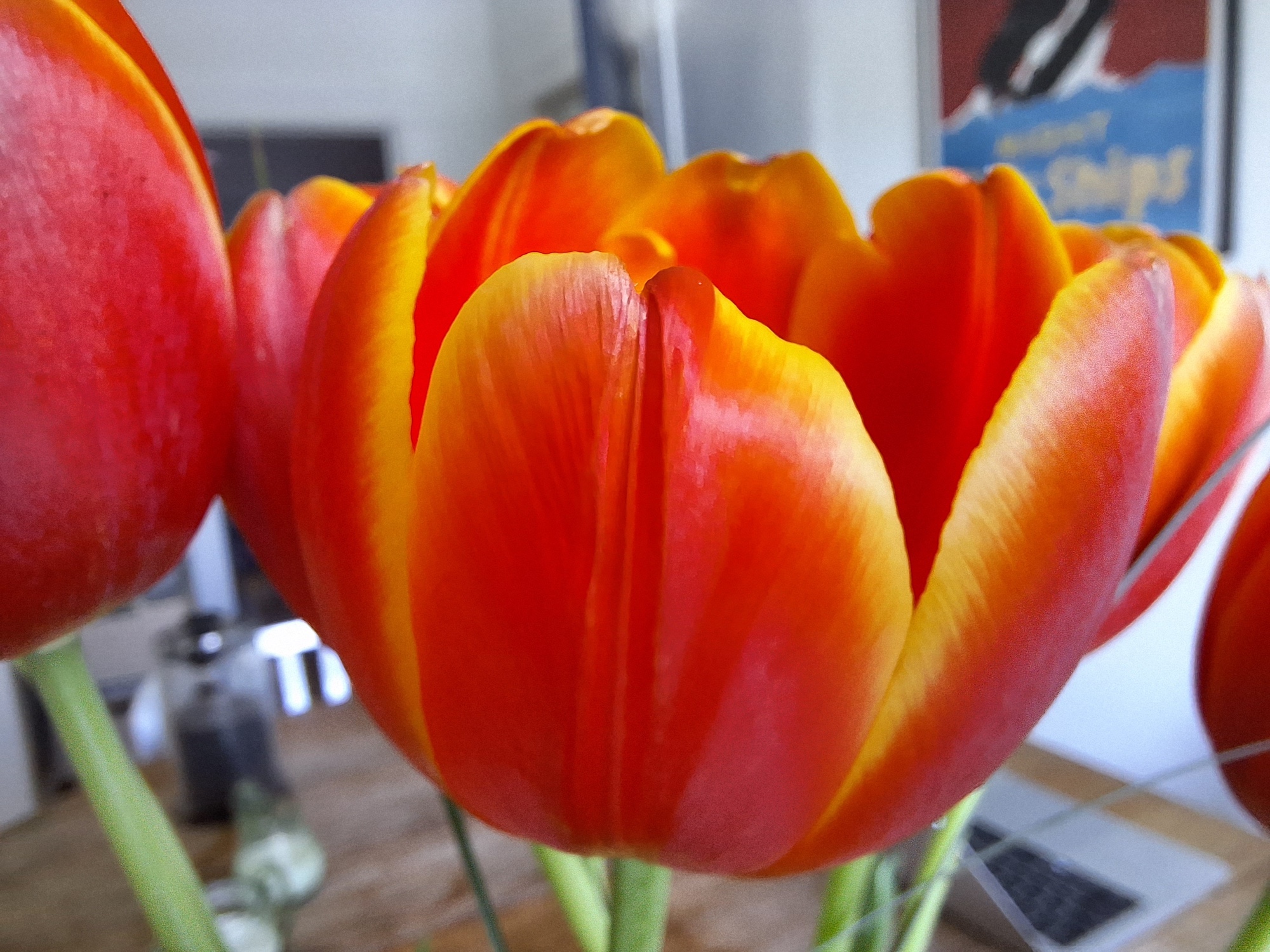
We should consider the macro lens on the Galaxy A54, too, even if I continue to question how much use the average person gets out of such an addition. This close-up of a tulip is relatively detailed — the orange color pops and you can make out some ridges forming on the petals. However, there's a touch of blurriness that I was never able to fully eliminate from my macro shots, so I hope you have a steadier hand should you actually use this lens.
The Galaxy A54 sports a 32MP front camera, and like the selfie cams on other Samsung phones, it has a tendency to over-smooth faces. The effect isn't too pronounced in the A54's shot of me, though it does try to play down freckles and other blemishes in a way the iPhone SE's front camera does not. The iPhone SE ratchets up the color a bit, with warmer tones, but it happens to be effective in this case. I prefer the iPhone shot, but I could live with that kind of selfie from the Galaxy A54.
Samsung Galaxy A54 review: Performance
Samsung looked to boost the Galaxy A54's performance over its predecessor by swapping out that phone's Exynos 1280 chipset for a more powerful Exynos 1380 system-on-chip. At the time of the Galaxy A54's launch, Samsung promised a 20% boost to CPU performance and a 26% improvement for GPU performance thanks to the chipset switch.
| Samsung Galaxy A54 | Pixel 6a | iPhone SE | |
| CPU | Exynos 1380 | Tensor G1 | A15 Bionic |
| Geekbench 5 (single core/multicore) | 781/2664 | 1057/2918 | 1718/4482 |
| 3DMark Wild Life Unlimited (fps) | 16.9 | 41.7 | 50 |
| Adobe Premiere Rush (Mins:Secs) | 1:12 | 0:49 | 0:27 |
We saw some of these gains in benchmark testing of the Galaxy A54. Unfortunately for Samsung, they weren't enough to close the existing performance gap with the Tensor G1-powered Pixel 6a. On Geekbench 5, the Galaxy A54's single-core score of 781 barely topped the A53's 745 result, while multicore performance improved much more dramatically to 2,664 from 1,888. However, the Pixel 6a still posts better single and multicore scores of 1,057 and 2,918, respectively.
It was a similar story with graphics tests, as the Exynos 1380 in the Galaxy A54 helped that phone produce 16.9 frames per second on 3DMark's Wilde Life Unlimited test, a modest gain from the Galaxy A53's 14 fps result. But that's still well behind the Pixel 6a's 41.7 fps result, not to mention the 50 fps the iPhone SE produces.
For real-world testing, we have phones transcode a video in Adobe Premiere Rush — a task that flummoxed the Galaxy A53 a year ago. We're pleased to see that the Galaxy A54 shaved 46 seconds off the A53's time, finishing the transcoding in 1 minute and 12 seconds. That's still well off the 49-second pace set by the Pixel 6a. And the iPhone SE, benefitting from Apple's A15 Bionic chipset, needs just 27 seconds to complete the task.
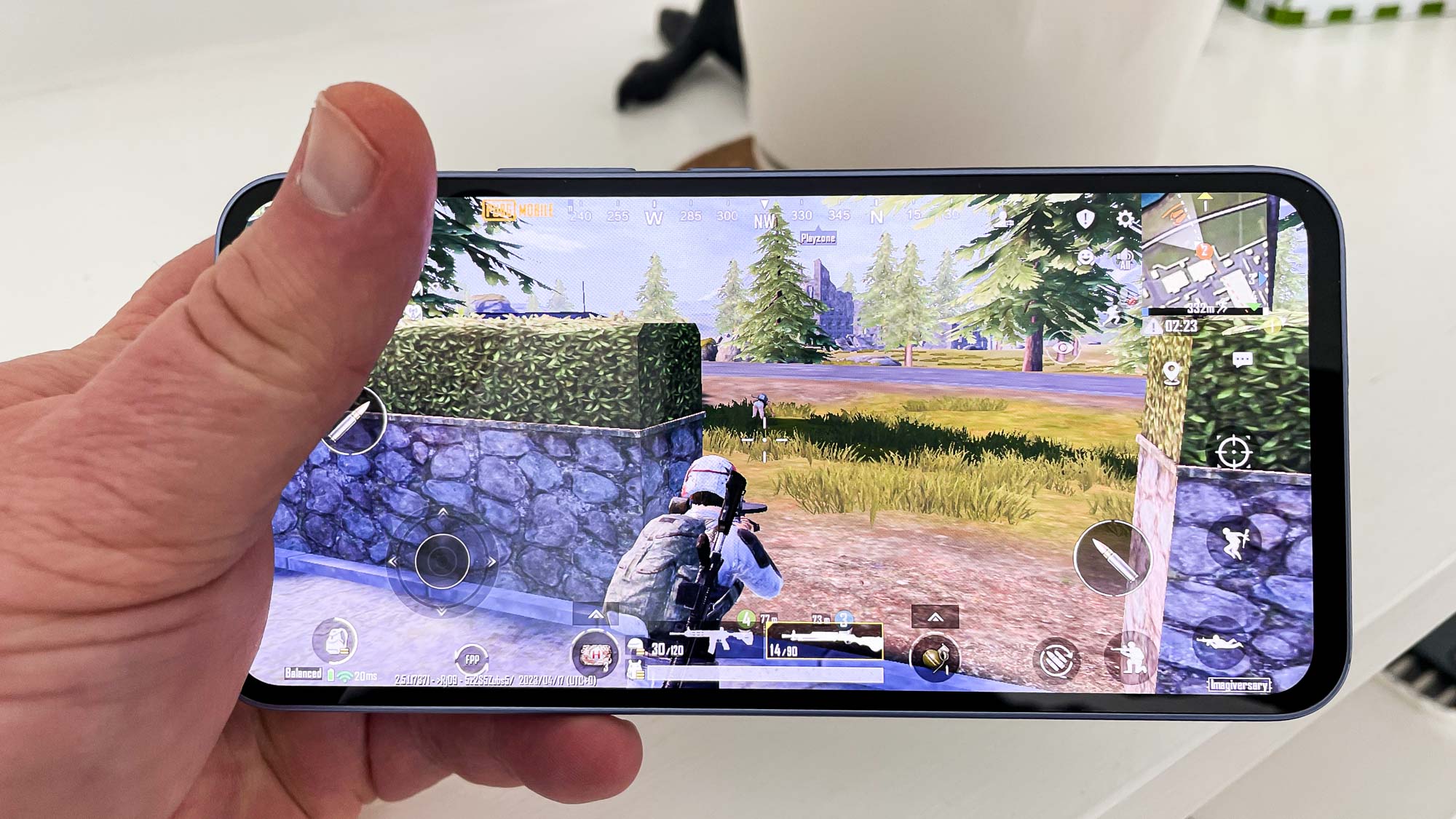
You'd figure the performance gap is only going to grow when the Pixel 7a arrives, as that phone will feature a newer Tensor G2 chipset. The Pixel 7, which also runs on a Tensor G2, posts slightly better performance numbers than the Pixel 6a, and we'd expect Google's new midrange phone to do likewise.
The benchmark results may not be encouraging, but at least the Galaxy A54 performed well in my daily use of the phone. I could switch between apps with very little noticeable lag, and demanding games like PUBG Mobile performed well on the device.
I also appreciated that the top speaker on the Galaxy A54 is a front-firing one, so that my hands didn't muffle the audio when I was playing a game in landscape mode. (The other speaker is on the bottom edge of the phone.) Phone calls sound clear on the top speaker as well.
Samsung Galaxy A54 review: Battery life and charging
If the Exynos 1380 doesn't quite deliver the performance boost we'd want to see, at least it manages power well enough to get the most out of the Galaxy A54's 5,000 mAh battery. With the A54's display set to an adaptive refresh rate that can scale up to 120Hz, the phone averaged a result of 10 hours and 20 minutes on our battery test in which we set each device to surf the web continuously over cellular. The Galaxy A54's result beats the average smartphone's by roughly half-an-hour.
Turn off that adaptive refresh rate feature, and battery life further improves. With its display locked at a 60Hz rate, the Galaxy A54 held out for 11 hours and 46 minutes, which would place it on our best phone battery life list.
| Samsung Galaxy A54 | Samsung Galaxy A53 | Pixel 6a | iPhone SE | |
| Battery size | 5,000 mAh | 5,000 mAh | 4,410 mAh | 1,624 mAh |
| Battery life (Hrs:Mins) | 10:20 (adaptive); 11:46 (60Hz) | 9:49 (120Hz), 10:38 (60Hz) | 6:29 | 9:05 |
| Charging speed | 25W wired | 25W wired | 18W wired | 20W wired |
To put those results in context, the Galaxy A54 lasted a little longer than the Galaxy S23 (10 hours and 27 minutes), though Samsung's flagship has a smaller battery and a much more power-efficient chipset. Among phones in the A54's price range, Samsung's latest phone outlasted them all. The iPhone SE lasted 9 hours and 5 minutes when our reviewer tested it, while the Pixel 6a turned in a disappointing time of just under 6.5 hours. Clearly, the Galaxy A54 is the midrange phone to get if you want something that lasts a long time on a charge.
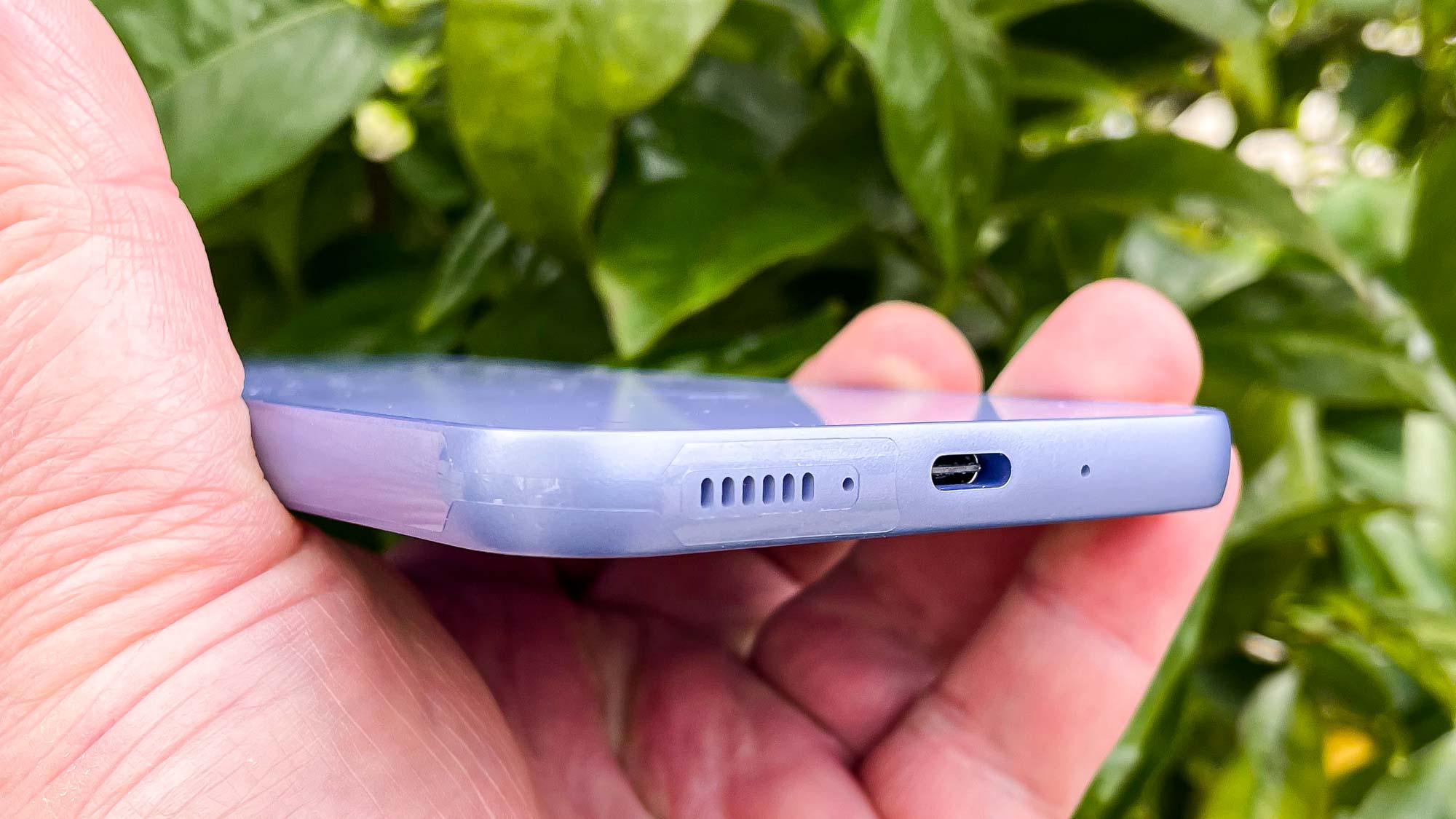
The Galaxy A54 should charge at a respectable clip, too, since it offers the same 25W wired charging speeds as the Galaxy S23. (There's no wireless charging support on the Galaxy A54.) We only managed to get the drained A54 to a 31% charge after half-an-hour, though that was with a 20W charger. Presumably, with a charger that took full advantage of the A54's charging speed, we'd get a number closer to the 55% result, though we wish Samsung would embrace faster charging speeds the way OnePlus does for its budget phones. The recently released OnePlus Nord CE3 Lite lets you charge at 67W clip.
Samsung Galaxy A54 review: Software and special features
You'll get Android 13 when you buy the Galaxy A54, which runs Samsung's One UI 5.1 on top of that mobile OS. That's the same software that debuted with the Galaxy S23, so this midrange phone will support the same features, including Modes and Routines.
Even better, after the Android 14 update arrives, you can still count on three more OS updates for the Galaxy A54, thanks to Samsung's policy of supporting four updates total, plus five years of security updates.
Samsung Galaxy A54 review: Verdict
There's a chapter to be written still in this Samsung Galaxy A54 review. Sure, this new phone tops the Pixel 6a in multiple ways, with better battery life, a brighter and more colorful display and a software update policy that extends the life of this phone for several years. The improved main camera competes well with the Pixel 6a, and the $449 price remains hard to beat.
But the Pixel 6a isn't Google's final word on budget phones. The Pixel 7a is coming — possibly as soon as early May — and that Galaxy A54 vs. Pixel 7a showdown figures to be definitive for anyone who wants to buy the very best budget phone.
We can't judge the Galaxy A54 on what could be coming down the pike, just what's here now. And overlooking a processor that delivered a modest performance boost at best, the Galaxy A54 nails the areas that matter to most smartphone users — camera, battery life and display. And it does all that in a very affordable package, vaulting it up the ranks of the best Android phones.
Philip Michaels is a Managing Editor at Tom's Guide. He's been covering personal technology since 1999 and was in the building when Steve Jobs showed off the iPhone for the first time. He's been evaluating smartphones since that first iPhone debuted in 2007, and he's been following phone carriers and smartphone plans since 2015. He has strong opinions about Apple, the Oakland Athletics, old movies and proper butchery techniques. Follow him at @PhilipMichaels.
